On our way back from PA, and no internet access, the wife and I stopped in for the final day of the Solar Decathlon. The shuttle dropped us close to the media trailer, and Charlotte filled us in as to who had won. As I expected, the University of Maryland maintained their lead from Friday and WaterShed (above) was declared the overall winner. Purdue's INhome surprised me by finishing second, New Zealand's First Light closed to third and Middlebury's Self-Reliance took fourth.
Appalachian State's Solar Homestead won the People's Choice award, leading the entire time, but only took 12th place overall, which was also a surprise to me.
1. Maryland - 1st in Architecture, (tie) Hot Water
2. Purdue
3. New Zealand - 1st in Engineering, (tie) Hot Water, Energy Balance
4. Middlebury - 1st in Market Appeal, Communication, Home Entertainment
5. Ohio State - 1st in Comfort Zone, (tie) Hot Water
6. SCI-Arc/Caltech - 1st (tie) in Hot Water
7. Illinois - 1st in Appliances
8. Tennessee - 1st (tie) in Hot Water
9. Team Massachusetts
10. Canada
11. Florida Int'l
12. Appalachian State - 1st (tie) in Hot Water
13. Parsons NS Stevens - 1st (tie) in Affordability, (tie) Hot Water
14. Tidewater Virginia
15. Team China
16. Team Belgium - 1st (tie) in Affordability
17. Team New York
18. Team New Jersey
19. Team Florida
Lines to see Watershed were already long, so we passed it up. We were able to walk right into about a dozen of the other projects without waiting much, though. Last week, Appalachian State and Middlebury had scored 3rd and 4th in the Architecture contest, while Purdue had tied for last place. These were the three entrants whose schools offered no professional architectural degree programs.
I once browsed a friend's copy of Architecture Without Architects which was a both a book and a MOMA exhibition of vernacular buildings and structures that rivaled high-style architecture. In the book, Bernard Rudofsky criticized stylistic architecture, writing, "part of our troubles results from the tendency to ascribe to architects - or, for that matter, to all specialists - excessive insight into problems of living when, in truth, most of them are concerned with problems of business and prestige." He claimed that, "vernacular architecture does not go through fashion cycles. It is nearly immutable, indeed, unimprovable, since it serves its purpose to perfection." I wondered if it was valid to consider any of these three houses as a sort of vernacular building.
I was hoping to get the reactions of Dave, Melissa and McKenna, who I had interviewed on those three projects last week. Happily the three houses were in the same row. I congratulated McKenna, then asked if, given INhome's low score in Architecture, she thought they might have done anything differently. No, she said, they were aware that they weren't pushing the design envelope, but they truly felt they showed that a solar-efficient house could be marketable to the average homeowner. INhome did remind me of my sister's suburban house. I had to respect that they placed well in all the other categories, but INhome would not have been in Rudofsky's book.
Melissa wasn't due at Self-Reliance until Noon, so I spoke to another young woman. I asked how a school with no architects could have done so well on the Architecture contest. With no hesitation, she attributed it to the, "effectiveness of a liberal arts education." I wondered if one her deans had said that in a speech. She was taking Arch Studies, Music and Physics, herself, and saw all three as interrelated, so my theory that Self-Reliance had been the product of an unconscious design process began to fade. My wife later said that Self-Reliance was her favorite house, due to the window garden "greenhouse wall," and it had been in my top three because I thought that they had a clean plan in a simple enclosure.
During my assembly interviews Dave had emphasized the passive efficiency of the Solar Homestead, and I frankly liked his mindset towards the technology. I didn't find him at the Solar Homestead, but another fellow answered my questions. He was proud of the People's Choice award but felt that Appalachian State should have fared better than 12th in the overall voting. He claimed that it was the only project built entirely by students, saying that the only thing they didn't build were the trailers that brought it to the site. He said that on Monday, contractors would show up to disassemble other houses, but that only the "guys with the beards" you saw in the Homestead would be taking it apart. The Homestead was also in my top three, but they were hurt by low scores in Comfort Zone and Energy Balance.
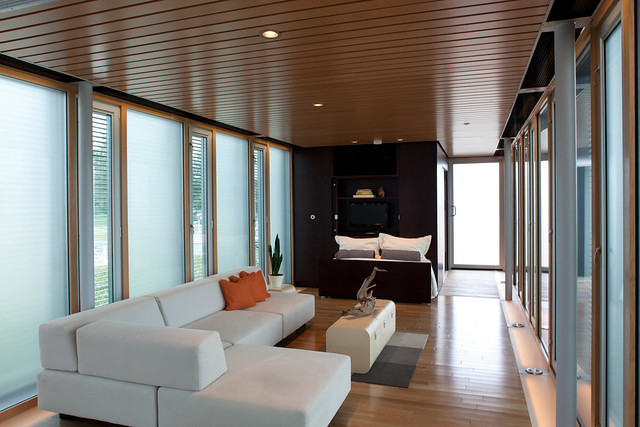
New Jersey, Tidewater, Florida and New Zealand were to the North. New Zealand was my other top three fav, and the most attractive to my eye, but we moved South. In the next row were Tennessee, Parsons NS Stevens and Florida International. Tennessee's First Light (above) was every bit as elegant as it had promised to be during assembly. I found Lauren again, and asked her if they had learned anything. She said that they had pushed the technology rather than affordability, and admitted that it may have been a mistaken strategy, but thought First Light was a great achievement, nonetheless.
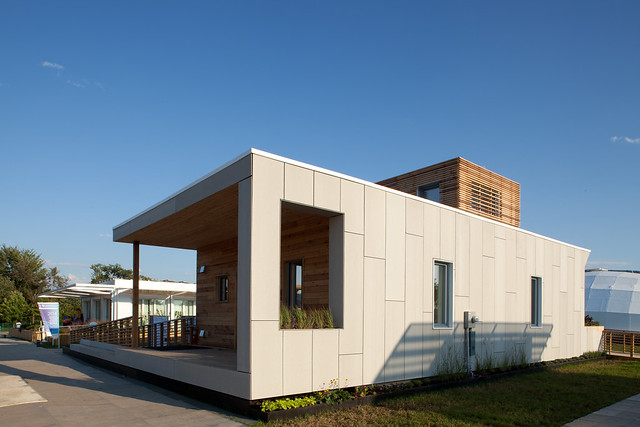
Parson NS Stevens built Empowerhouse (above) for Habitat for Humanity. The young woman I buttonholed had a series of complaints about the scoring, mostly the spreads in scoring each contest. I checked later, and there were 30 point spreads in Market Appeal, Comfort Zone, Hot Water and Engineering, 50 point spreads in Affordability and Communication, and a 100 point spread in Energy Balance, but only a 16 point spread between the best and worst Architecture scores. She realized that judging was subjective, but felt the scoring had the effect of penalizing good design and rewarding mediocrity.
Florida International's Perform(d)ance house (above) had a lot of hard, white surfaces. The exterior was metal, the interior was plastic laminate and solid surface plastics. Three walls of the Bathroom core defined Kitchen, Living and Master Bedroom in an otherwise open plan. I thought it severe, but it is a popular style in Florida.
At Team Canada's TRTL (turtle) house (left), I asked one of the young women what she felt about tying for last place in Architecture. She thought their spaces were much more livable than others that scored higher, but as an architecture student, she said she was used to subjectivity in the review process. She said she had encouraged her flustered non-architect teammates not to take it too seriously. With the interior frame draped in canvas, Turtle felt like a tent inside. It occurred to me that it would also work as a house built into a hill because there is no fenestration on the North side.
Team China's Y-Container (above) plan featured equal legs for dining, kitchen/bathing and entertainment. There were some clever screens on ceiling tracks, but the spaces were again severe.
Team Belgium's E-Cube (left) used the sort of frame you'd find supporting the shelves in a big box store upon which was affixed an envelope of structural insulated panels. It was the only house with a second floor. E-Cube scored next to last in market appeal, understandable as a European building judged by Americans, but was one of five teams that won zero points for Energy Balance, which is fatal in a competition of solar houses.
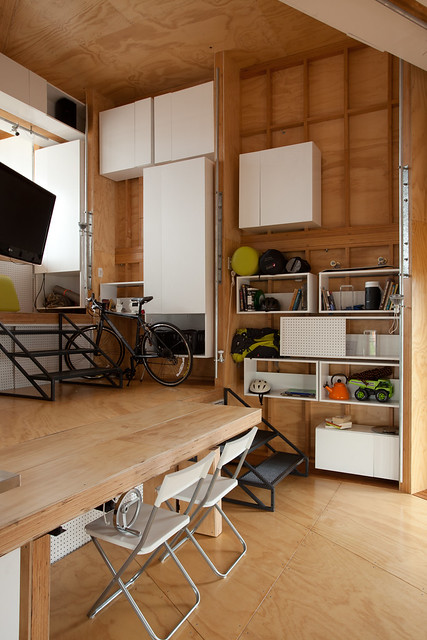
We stood in line to see Sci-Arc and CalTech's CHIP house (right) , which was the polar opposite of INhome, in that it was design-aggressive, but rough in execution. The interior resembled a garage that had been turned into an apartment. It had some scary level changes. Although they finished sixth overall, two fellows just outside made no bones about claiming that they had been shafted in the subjective contests. "In objective categories, we kicked ass!" but they said they just couldn't convince the jury that a market existed for their casual, loft-like interior. Looking at the numbers, Market Appeal essentially dropped them from 2nd to 6th place.
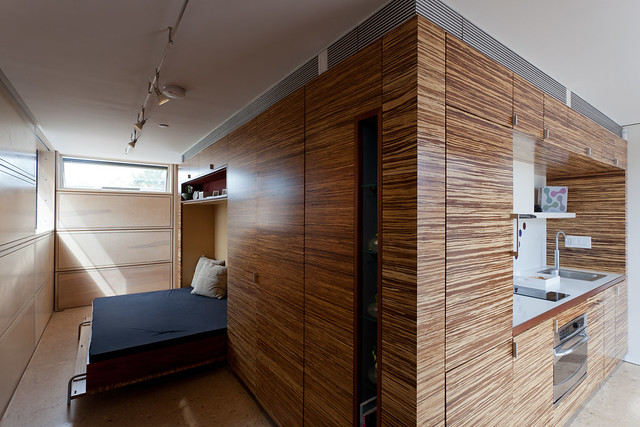
It was getting very cold by 2 PM, so our last stop was Team NYC's Solar Roofpod (above). The concept was that the house would break down to components that could be transported to building rooftops via elevator. But with another layout in which the floating core defined spaces in an open plan, it looked like the rural and suburban solutions. They also scored zero for energy balance.
Perhaps the comments I heard sound like sour grapes, but they reminded me very much of what went on after every project jury in architecture school. Every designer becomes invested in his own decisions. Certain students would doggedly address every requirement of the stated program, and be flummoxed when the jury members were more excited by a project that stretched, or even flat out disregarded the program in favor of artistic gestures. Most students eventually learned both that jury members are often more impressed by glorious mistakes than solid mediocrity and that jury members have personal preferences.
While the preponderance of points were in objective categories, the Decathlon judging differed from design juries in that subjective Market Appeal points counted for more than subjective Architecture points, and seem to have rewarded the familiar over the experimental - which worked against some expectations.
Nevertheless, to my mind, all these students enjoyed a remarkable experience, and we have seen that the competition need not be limited to architecture & engineering schools.




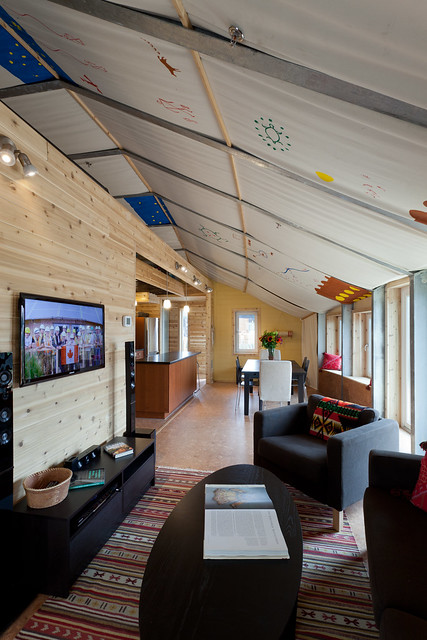
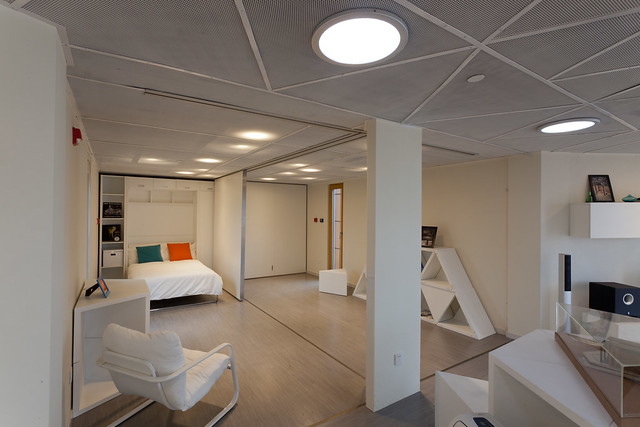



Comments
Cool writeup.
Question: what was the basic criteria for the "energy balance" score? Seems strange so many would get a zero there.
by kgb999 on Mon, 10/03/2011 - 2:48pm
Excellent question:
Most teams scored points in the Comfort Zone and Hot Water contests, but in addition to running the house, teams are supposed to accomplish certain power-intensive tasks, such as powering a plugin hybrid vehicle, drying towels, etc. It has been grey, cloudy, and pouring rain around Baltimore for the last two weeks, and I'd imagine DC fared about the same.
3rd place New Zealand was able to dry their towels with their hot water racks instead of generating and using electricity. But teams that were counting on strong sunlight to generate all the electricity they needed may have faced a reality moment.
by Donal on Mon, 10/03/2011 - 3:13pm
I found this on Ohio State's decathlon blog. Sounds like it was touch and go:
MD, Purdue, Sci-Arc/CalTech and four other teams scored perfect 100s, but OSU scored only 88 points in Energy Balance, so they must have been -6 KWh negative.
by Donal on Tue, 10/04/2011 - 9:13am
Thanks for bringing this forward. I envy you being able to visit the actual creations and there is nothing more contagious than design students of any stripe.
I'm struck by how large the homes are, maybe I'm not seeing the scale. Seems the Parsons one was much smaller. I like working with small spaces, seeing how much can be achieved in such.
I love modern design from an esthetic point of view but for actual daily living think there must be nooks and crannies which provide a more "wrapped" feeling.
by Oxy Mora on Mon, 10/03/2011 - 3:20pm
I built several "cottages" on country property in Texas last year and experimented with materials, insulation, etc., and using local labor, fortunately no building codes there. Then in January I roughed out a two story barn with a cement pad which I look at every weekend and try and figure out what the next steps are. As for my local neighbors, they are still trying to figure out what the hell I'm doing overall. Usually get something like, "Gonna rent these shacks when that lake goes in, huh?"
by Anonymous (not verified) on Mon, 10/03/2011 - 3:27pm
by Verified Atheist on Mon, 10/03/2011 - 3:29pm
Thanks, Va. That was very useful, and gave me an idea on a sliding wall concept.
330 feet, wow, amazing.
by Oxy Mora on Mon, 10/03/2011 - 3:50pm
The houses had to be between 600 and 1,000 Square Feet. WaterShed was almost 900 SF and Self-Reliance was 990 SF. Not sure about Parsons, but they plan to add a second story after moving it to Deanwood.
Our 2 BR house is 950 SF, so we found it interesting to compare spaces with the entries.
by Donal on Mon, 10/03/2011 - 3:37pm
Thanks Donal. I assume you designed your own house. That can be the most challenging assignment of all.
Maybe all this design "stimulus" will get my animal spirits going again. It's been so hot that I have just delayed doing any more projects.
In terms of the "green revolution" we sometimes overlook the most basic things. We recently painted a coating of radiant barrier on a N.Texas house which had not used solar board for roofing and the effect was amazing.
by Oxy Mora on Mon, 10/03/2011 - 4:00pm
Our house was built in 1949 - coal was so cheap then that no one bothered with insulation. We gutted it and insulated everything, but we have a bad orientation for passive solar.
by Donal on Mon, 10/03/2011 - 4:18pm
I love this stuff!
I do not know how else to put it!
Instead of these nonsensical energy eating edifices....
LET US TRY SOMETHING ELSE!
by Richard Day on Mon, 10/03/2011 - 7:42pm